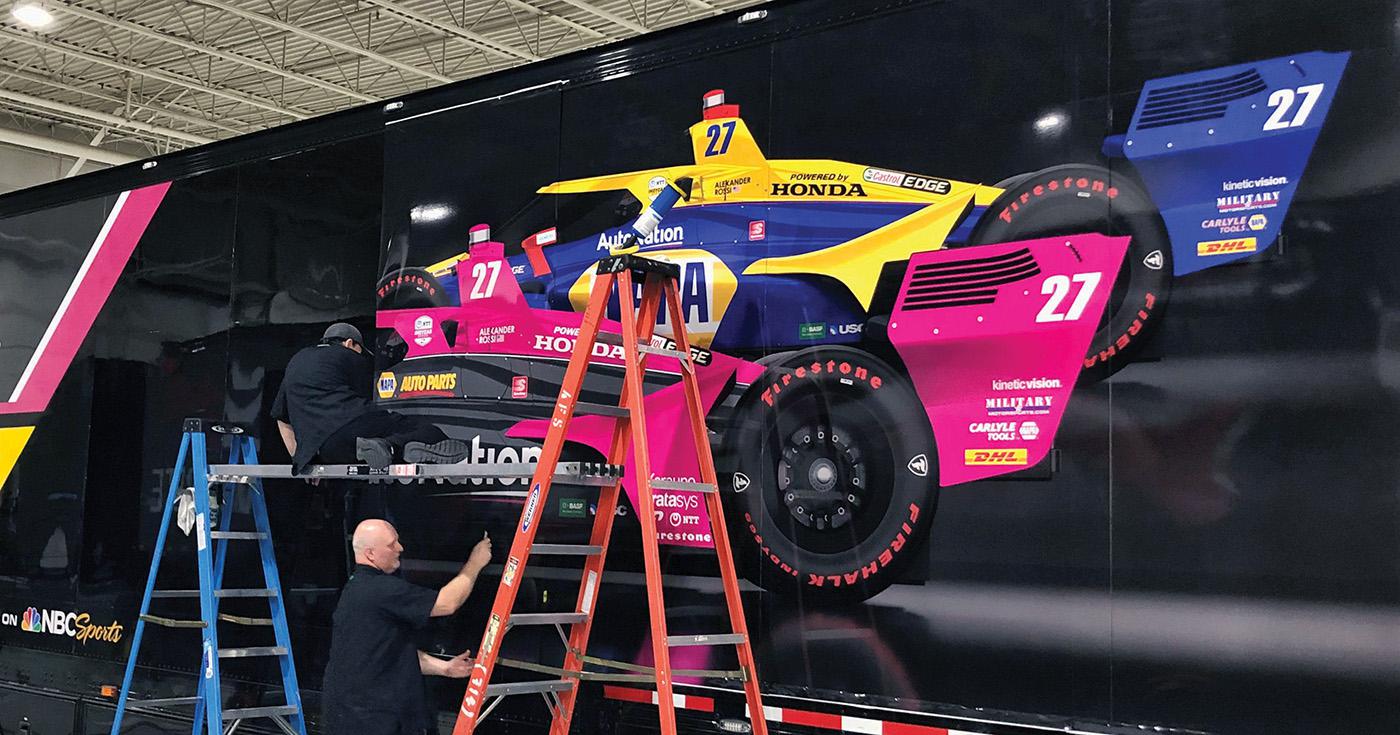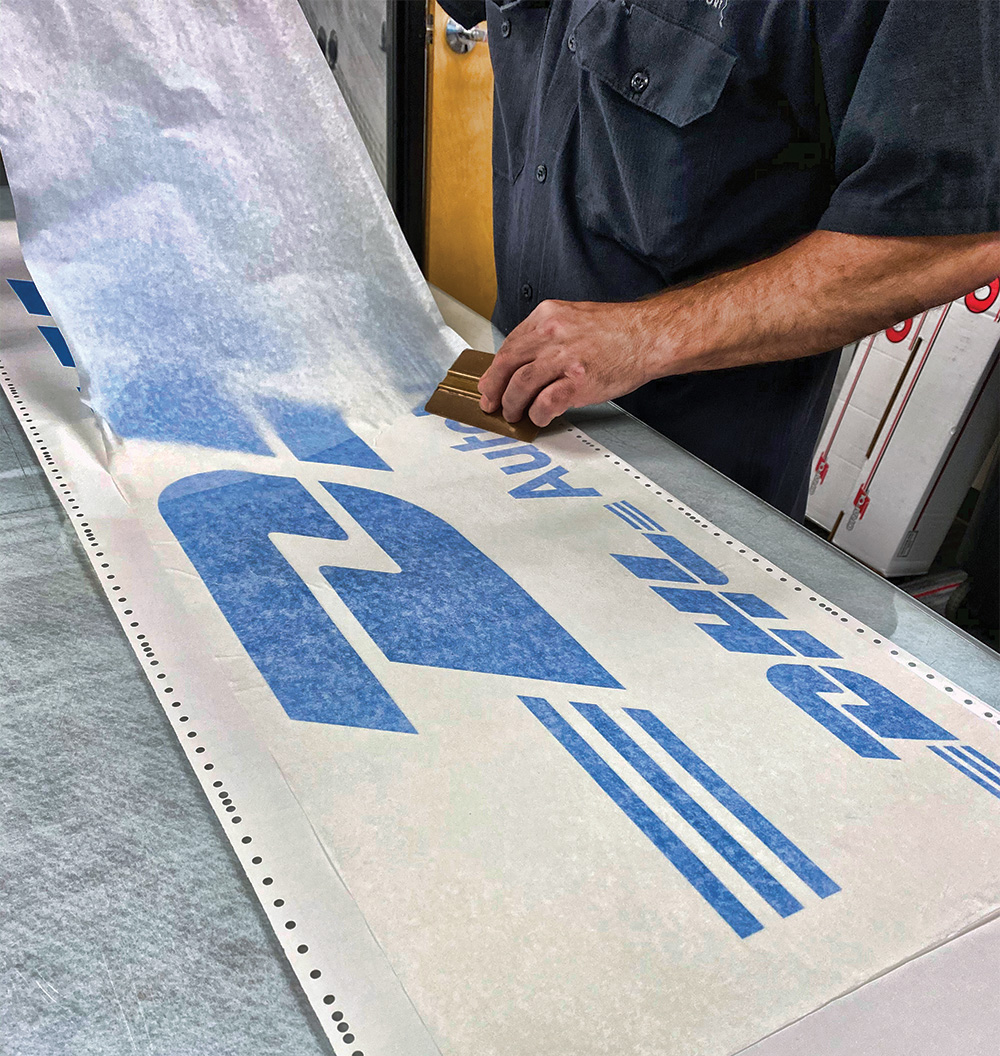GRAPHIC INTERFACE

Photo courtesy of ORAFOL
From basic vinyl numbers and lettering to full vehicle wraps, shops are creating under-the-radar profit centers by leveraging new technologies, resources, and training programs.
Whether it’s something simple like car numbers or sponsor logos, or a more complex job like a complete hauler wrap, the need for graphics is constant. So constant, in fact, that many professional race teams have the designers and equipment to handle their graphics needs in-house. Conversely, there are graphic and signage companies whose staff are racers themselves. Their involvement with their racing communities—and ready access to parts from their own race vehicles—helps them tailor graphics to suit their specific needs.
And then there’s the hybrid of the two: race shops that have added graphics and wrap applications to the list of services they offer. For some it’s an extra level of race customer support, while others have earned additional revenue by offering these services to non-racing businesses.
Race shops that are considering adding graphic design and vehicle wraps should do so carefully, say the sources we spoke to.
“There will be growing pains,” said Josh Culverhouse of ORAFOL, an international manufacturer of vehicle wrapping products and other specialty films with an American division based in Black Creek, Georgia. “You’re not going to buy all your equipment and be up and running the next day. You’re going to learn things, and there will be a lot of trial-and-error.”
“You have to crawl before you can walk,” agreed Rick Hall of Rick’s Performance Center, Las Cruces, New Mexico. “Give it plenty of time to grow.” Hall started making vinyl numbers and lettering for race cars in 2007, leaning on previous experience his manager, Lloyd Turner, had working with graphics. In 2016, Hall decided to up his game and invest in more equipment. Since then, Rick’s Print Shop has “afforded us quite a little niche here.” Hall’s son, Chad, who has a degree in graphic design, recently joined the team and will help it branch out further.
“There’s only so many race cars out here in Las Cruces,” Hall explained. “So, we’ve been doing box trucks, plumbing vans, electrical vans, plus all the signs for our new race track, Vado Speedway Park. With Chad coming on board, we can actually go out and ask for business.”
Pegasus Auto Racing Supplies in New Berlin, Wisconsin, is another shop providing graphics to its customers. “We do vinyl numbers and lettering on a limited basis,” John Haydon said. “Sometimes we get customers looking for something fancier than what we can do, but the basic stuff is still working for a lot of our customers.”
DESIGNER NEEDED?
“One advantage to our basic offering is that almost anybody in our company can go back and work the machine,” Haydon said. “We don’t have to have somebody who’s gone through specialized education to run it. I know there are much fancier machines that print on the vinyl, but a shop would have to be pretty serious about getting into the graphics business to not only have the financial outlay, but also have staff who can run it. You would also want to have someone who can do graphic design.”
Culverhouse agreed that having a graphic designer in the shop is a definite advantage when creating graphics beyond simple car numbers and driver names. If a shop doesn’t have an employee with graphic arts experience, “you should be able to find a freelance graphic designer or somebody who has been in that space before that you can partner with. Or bring in an intern and give them an opportunity to be in that environment. They’ll have just enough know-how to help you get on your feet. That’s a good starting point.”
EDUCATIONAL RESOURCES
There are many resources race shops can take advantage of to learn about the mechanics of graphics and wraps, Culverhouse said. “There’s a lot of content available, including YouTube channels from sign and graphics companies, race companies, the printer companies, laminating companies, and media manufacturers. Folks can research and really digest this information to make informed decisions.”
Do as much homework as you can, he added. “Identify who the players are, the different manufacturers for the materials that you would need, from the inks and the print media to the equipment. A lot of that starts with the distribution channels. Most of the upper-echelon graphics distributors have outside or inside sales reps they can call and get basic information about what it would cost to get basic equipment for starting a shop.”
Those distributors will often host open houses and offer classes to help those new to the industry get hands-on experience with the products, Culverhouse said. ORAFOL, too, teaches application training classes, “where they come in and learn how to do the installation of the graphics on a vehicle.”
Plus, “a lot of our authorized ORAFOL distributors have access to new printer kits or new plotter kits. These include a color chart, an ink jet media selection guide, and sample material. That customer can experiment with those materials to reduce the cost of their training process, get some of that trial-and-error out of the way,” he concluded.
SHOP SETUP
What does it take to set up a graphics shop? The basic components should include a computer design station; a printer and a plotter or a single machine that does both (the former prints intricate designs in multiple colors, while the latter does simpler, one- and two-color vinyl and film designs); a laminator (to apply UV protection film over the graphics); a work table large enough to accommodate the printed panels; a self-healing cutting mat for the table; cutting tools; installation supplies; and the various media to be printed on.
Size matters when planning the print shop, advised Culverhouse. “In the race industry, where there are a lot of trailers, you have to think larger format than just race car decals,” he said. “For any trailer application, if you’re doing a full wrap, you’re going to produce wallpaper-like panels that will be up to 60 inches wide.” Keep that dimension in mind when choosing the size of the printer, plotter, and laminator, and make sure their sizes match.
The print shop’s location matters, too. “It’s incredibly important to not operate your equipment and your processing area in same area where you might have machinists grinding away or drilling carbon fiber and putting dust in air,” he continued. “You want a clean, secure, enclosed environment separate from the day-to-day race shop.”
At Rick’s Print Shop, the Halls have a 64-inch Roland Printslinger printer, a separate Roland CAMM-1 Pro plotter, and a Drytac JetMounter laminator. Installations are handled outside the shop in Hall’s barn. “Ideally,” he said, “we would have an area where we can install in-house. If people saw graphics going on a race car or van when they walked in, they’d immediately say, ‘Hey, look what they do.’ It would be very ‘graphically’ appealing, pun intended.”
The financial outlay to set up a shop like Hall’s will be in the tens of thousands of dollars. (A large-format Roland printer had an MSRP of around $20,000 at the time of this writing.) But there are ways to save money. “I did our worktable on the cheap,” Hall said. “I found an old pallet rack, cut it apart, made it wider, made it shorter, put a piece of plywood underneath it, and a five-by-10-foot piece of 3/8-inch steel beneath that. It’s a nice, strong, flat platform for our layout.”

SOUND ADVICE
When asked for advice to pass on to race shop owners that may be thinking about adding a graphics and wrap business, Haydon said, “It would be smart at the beginning to decide how major a part of your business you want the graphic side to be. That level of commitment would determine how much of a financial outlay you’re looking at. Using us as an example, it was never meant to be a big part of our business, so we have a fairly basic machine and a basic offering. But if someone really wanted graphics to be a core part of their business, it would make sense to get more intricate equipment that can do more.”
Because his shop doesn’t install the graphics, Haydon found it important to provide installation instructions to his customers. “We had replaced a fair amount of numbers that customers had gotten all wrinkled or crooked. But then we put together some easy-to-follow instructions that make the process a bit more fool-proof. Since we started sending those with every graphics order, we’ve had fewer complaints. The whole process has gone a lot smoother for them.”
“We always say this: Ask first before you do, instead of asking what happened after it happened,” said Culverhouse. “So many folks out there, they’ll do something they have no experience with, take the risk, and it burns them the next day, or a week later, or a month later. Go through a thorough discovery process with your client. Identify what the requirements are, and then pull in the proper resources and professionals. Ask your distributor about the support they offer, or support from the manufacturer. Call in professional guides that can help steer you in the right direction and help you to a positive outcome.”
Hall’s first piece of advice was, “Avoid the sharp end of the stick when you’re cutting. Sharp end down.” And he, too, said to review the specifics of a job with the client. “Get actual dimensions rather than having a guy hold his hands up and say, ‘I want it this big.’ Have him sign off on the size and the design.
“And have the customer proofread the design,” Hall added. “Spell-check is a good thing. ‘Chiropractic’ does have three Cs in it. We made that mistake. We spelled a really good customer’s entire wrap incorrectly.
“We haven’t made all the mistakes,” Hall continued. “We’re going to make more. Sometimes you have to laugh at them and go on, and realize you’re not going to make money on that job. They can be expensive lessons, but those are the best lessons.”
SOURCES
–
 MEMBERSHIP LOGIN
MEMBERSHIP LOGIN JOIN PRI
JOIN PRI


